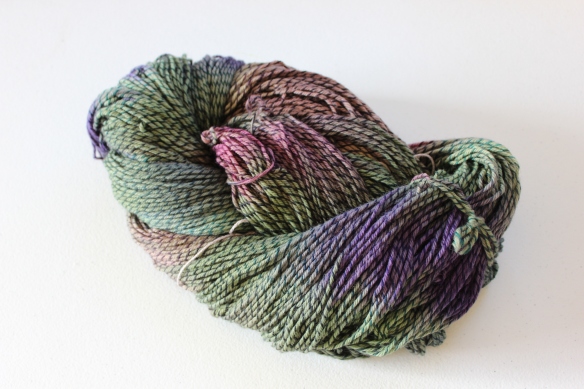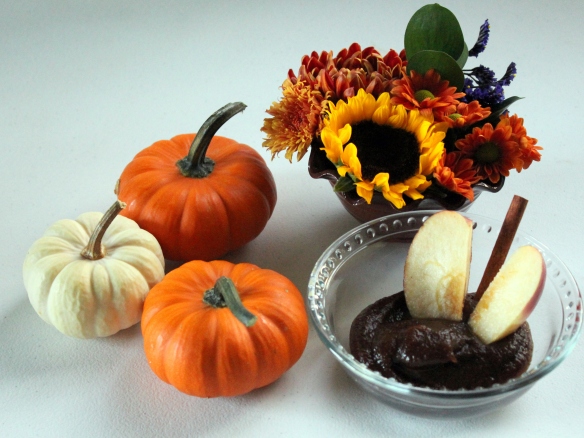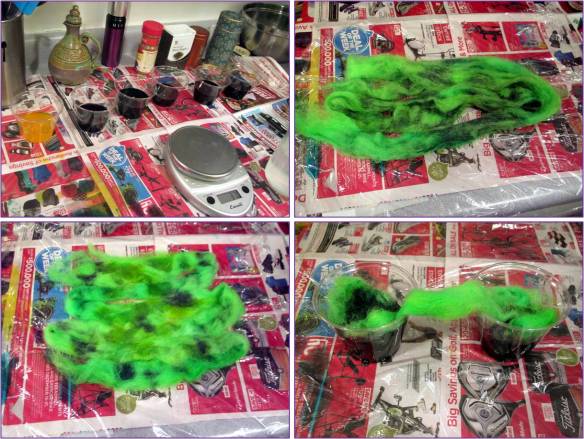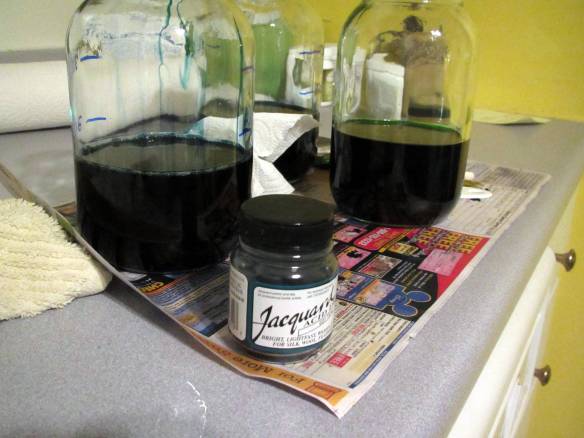It appears that yarn dyeing, like yoga, is one of those exercises designed to teach me patience, acceptance, and observation without judgement. (These, by the way, are not easy things for me.) It frustrates me when I have a vision of what I want and can’t predict the best way to achieve that vision. At the same time, it’s kind of fun to say “screw it!” and just see what happens. That’s what went on in my kitchen this weekend.

I call this Splattered Turquoise.
If you remember from Friday’s post, I dyed this skein twisted up in the hank, more or less just to see what would happen. When I took it out of the pot, the whole thing was bright blue and I thought my little experiment had failed. But, when I unwound the hank, the undyed bits of natural grey/brown yak/silk were visible.

Glamor shot.
I had been hoping to use this technique to achieve a gently variegated, speckled look… which I did not achieve. The turquoise was far brighter than I had anticipated (even at a depth-of-shade of only .25) and the variegation is not subtle at all. I think I will eventually overdye this with a pale green or a solid blue to get a lower contrast variegation and use it in a cowl or hat or something. Still not sure what I’ll do with the rest of the sweater quantity, perhaps just a DOS 0.10 solid overdye to give it some color, we’ll see.

Silver Grey overdye… barely changed it at all.
My next plan was to overdye 2 skeins of BMFA Twisted (2 plies of Merino wool plied with 1 of superwash Merino (the darker strand)) to achieve a more subtle variegation for use in a sweater. The photo above shows a skein after using up my entire stock of Silver Grey. It barely made a difference! In fact, it really only seemed to affect the superwash strand strongly (superwash yarns take up dye at a faster rate than non-superwash). Turns out that a DOS of 1.5 is not very strong for such a light color dye.

Back in the dyepot…
Back in the pot it went, this time with Midnight Black at a DOS of 0.25. I was hesitant to use a LOT of dye at once, because you can’t undye things, so the process took forever as I tried something, added more dye, checked results, added more dye, etc. The poor Faisco was getting a headache from suffering through basically an entire dye of vinegar/citric acid/dye mixtures simmering away on the stove.

Dye results with DOS 0.25 black.
I think I’m happy enough with these results. The initial overdye with Silver Grey sort of dampened the colors a bit and changed their tone, and then the Midnight Black darkened them up overall. The yarn is still quite variegated, you can see the green/purple/pink/blue sections fairly clearly, but I think the overdye did make them more cohesive and hopefully more garment-appropriate. I don’t want to subject these skeins to any more dye, a couple strands are already starting to felt up a bit from all the boiling, so hopefully I’ll like it well enough when I swatch!
Have you tried dyeing your own yarn? How do you get to what you envision, or do you just throw caution to the wind and see what happens?











 Here are some of the results… Top left is the yellow dabbed with grey, top right is the half chestnut and half amazon green dipped bundle, and in front is the one with turqoise poured on.
Here are some of the results… Top left is the yellow dabbed with grey, top right is the half chestnut and half amazon green dipped bundle, and in front is the one with turqoise poured on. And the rest: top left is the amazon green alternated with purple, top right is the one with silver poured on, bottom left is the yellow immersion dye, and bottom right is the one on which I painted stripes of yellow, chestnut, and green.
And the rest: top left is the amazon green alternated with purple, top right is the one with silver poured on, bottom left is the yellow immersion dye, and bottom right is the one on which I painted stripes of yellow, chestnut, and green.


 I decided to dye some Romney yarn from a local farm, some Elsawool Cormo yarn, and some BFL/Gotland locks. I somewhat haphazardly bundled the locks together with cotton yarn before dyeing.
I decided to dye some Romney yarn from a local farm, some Elsawool Cormo yarn, and some BFL/Gotland locks. I somewhat haphazardly bundled the locks together with cotton yarn before dyeing. Darwin approved of this plan. (Can’t turn my back for a second!)
Darwin approved of this plan. (Can’t turn my back for a second!) Then into a pre-soak they went! The book said to soak in a water/vinegar solution while the video said water and Synthrapol, a detergent and wetting agent that helps the wool fibers open up. So I soaked them in a little bit of both.
Then into a pre-soak they went! The book said to soak in a water/vinegar solution while the video said water and Synthrapol, a detergent and wetting agent that helps the wool fibers open up. So I soaked them in a little bit of both. I did a full immersion dye on the Romney and the BFL/Gotland locks. I used the teal dye, the citric acid solution necessary to make the dye stick, and lots of water so the fiber was completely covered. Here it is at the end of simmering on the stove for half an hour, you can sort of see how the dye is now entirely on the fiber and the water around it is relatively clear.
I did a full immersion dye on the Romney and the BFL/Gotland locks. I used the teal dye, the citric acid solution necessary to make the dye stick, and lots of water so the fiber was completely covered. Here it is at the end of simmering on the stove for half an hour, you can sort of see how the dye is now entirely on the fiber and the water around it is relatively clear. For the Cormo I tried a low-water immersion dye, which is supposed to lead to more variegation in the skein for that kettle-dyed look that I love. For this you only put enough water to barely submerge the skein and then you randomly pour the dye over it and DON’T stir, so that it absorbs more in some areas than others.
For the Cormo I tried a low-water immersion dye, which is supposed to lead to more variegation in the skein for that kettle-dyed look that I love. For this you only put enough water to barely submerge the skein and then you randomly pour the dye over it and DON’T stir, so that it absorbs more in some areas than others. And there are my results! I love the depth of color in the teal yarn and fiber, I’m very happy with those. I’m not a huge fan of the day-glow green color that the Cormo came out and it’s a bit more solid than I had wanted. However, no worries, I can always overdye it! I ordered some more dye colors (grey, yellow, chestnut, and turquoise) and am planning to experiment on some fiber that I will dye day-glow green and then combine with the new dyes to see what brings me closer to what I had envisioned.
And there are my results! I love the depth of color in the teal yarn and fiber, I’m very happy with those. I’m not a huge fan of the day-glow green color that the Cormo came out and it’s a bit more solid than I had wanted. However, no worries, I can always overdye it! I ordered some more dye colors (grey, yellow, chestnut, and turquoise) and am planning to experiment on some fiber that I will dye day-glow green and then combine with the new dyes to see what brings me closer to what I had envisioned.